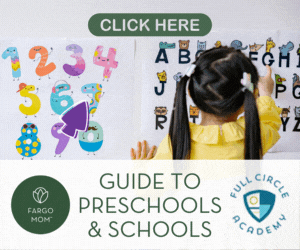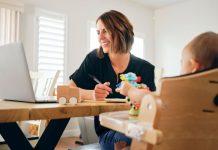Please tell me I’m not the only one who this happens to. You get a text from a friend asking to borrow a random item. An ugly holiday sweater, maybe a hot glue gun, or something really specific — like size 3T purple leggings.
Instantly your mind starts to ponder the request and the frantic searching begins. Would it be in with my kids’ stuff? Or maybe office supplies?
After an hour of looking, you come up short, but refuse to accept defeat. So you say to yourself, “I’ll just go buy one.”
And then, low and behold, exactly 48 hours after said purchase, you stumble upon the sought after item. Put simply, the problem is usually the result of one of two issues: excess or clutter.
We have too much stuff!
And when we have too much stuff, we don’t know what we have, where we keep it, or how to organize it. And it becomes difficult to effectively manage it all. This is precisely where the theory of minimalism can help.
So, what is minimalism?
In short, a minimalist lifestyle is one that focuses on owning the things that really matter. It is a true “less is more” way of thinking. An approach that focuses on intentionality, efficiency, and the principle that each item we own has a clear purpose and a “home.”
Minimalism: Where to Start?
Let’s talk about how we can dabble into the world of minimalism, without going all in. How we can reap the benefits of the overarching theories and practices, without getting rid of all of our prized possessions, or losing our sanity in the process.
Do me a favor and picture that one spot in your home that drives you nuts.
Maybe it’s a kitchen drawer so full of utensils that the stars have to be aligned for it to open and close properly. Perhaps it’s the corner of your laundry room where outgrown kids’ clothes are piled so high they’re about to touch the ceiling. Or, a toy bin that seems to overflow more and more each week.
I’m willing to bet that when you think about this area (or even walk by it), you experience an emotional response. You might feel irritated, annoyed, embarrassed, or stressed out.
That’s because physical clutter leads to mental clutter. And in a world where hundreds of things compete for our attention all day long, the last thing we need is mental clutter from possessions in our own home.
Ok, do you have that problem area pinpointed in your mind? That’s the perfect place to start incorporating minimalism right now.
Minimalism Methods
1. Put Your Stuff to the Test
Beautiful. Functional. Sentimental.
Wouldn’t it be great to get to the point that everything in your home falls into at least one of those three categories? With every picture on your wall bringing you joy. Each item in your kitchen serving a distinct purpose. And not a single cozy blanket in your den going unused during winter.
Try it for a few minutes. Walk around your house and mentally put each item to this simple test. Is there anything that doesn’t fit? Doesn’t flood you with a great memory, bring you happiness when you’re around it, or serve a direct purpose? Get rid of it!
But, be aware that even if something is functional, it shouldn’t be repetitive. That’s right, you don’t need seven spatulas.
2. Everything Has a Place
Everything we own should have a home — a place dedicated to storing or housing it. It sounds simple in theory, but it’s an effective way to reduce clutter and makes it much easier to find things!
3. Tuck It Away
Another fun way to practice minimalism is to try the “tuck it away” method. And a good place to start is in your kitchen.
Go through each drawer and cupboard and be strict with yourself. Box up anything that you don’t consistently use and tuck it away for 90 days. Set a reminder on your phone and when the three months are up, take out that box and go through it. Only put back the items you truly missed. And, if you’ve forgotten about the box entirely, you’re probably safe to get rid of the whole thing.
Start Small
You can ease into the concept of minimalism. Maybe carve out 30 minutes this weekend to tackle one corner of a room, a single drawer, or a small coat closet. After you go through that space, if you like how it looks or makes you feel, then keep going.
Or, maybe try adapting a “one in, one out” method. For example, if you buy something new (like a coffee mug), you have to get rid of one first.
Again, try to think of these methods as ones you can take bits and pieces from.
You don’t have to marry minimalism. Maybe just go on a couple dates and see if there’s chemistry.
Don’t Throw It All Away
So, you’ve gone through a few areas of your home and have some full garbage bags to show for it. Nine times out of 10 those possessions don’t need to be tossed in the trash. They can be donated, sold, or passed on to someone else. There are so many good ways that we can get rid of our stuff without simply throwing it away.
Find Your Minimalism Style
When it’s all said and done, you could find that minimalism is a good fit. You might love the extra space, more streamlined look or feel to your home, and the freedom of getting rid of some of your stuff.
If that’s the case, just make sure you have a plan in place to keep the clutter and excess from creeping back in. Then once you get your spaces to the desired “level” of minimalism, schedule some time to check in and make sure you’re maintaining them. This might be as simple as setting a quick reminder on your phone.
On the other hand, you might reaffirm that you’re the type of person who loves owning 50 handbags. And that’s okay!
At the end of the day, the changes we make to our lifestyles should make us happy. Make us proud. Make us better.
And it’s okay to be a minimalist in the kitchen, but not in the toy room. Find what works for you.
















